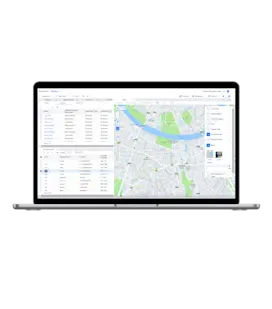Fleet of the Future: Why Moving to Electric Vehicles Is Good for the Environment and Your Business
Fleet of the Future: Why Moving to Electric Vehicles Is Good for the Environment and Your Business
Fleet of the Future: Why Moving to Electric Vehicles Is Good for the Environment and Your Business
14 Oct 2021
Aptean Staff Writer
For fleet owners, making the switch to electric vehicles sounds like a daunting task. But new government mandates and rising fuel costs are making the transition a necessity, rather than an option.
What does this mean for fleet owners?
It means that your company needs to think about making the switch to a sustainable fleet sooner rather than later.
Taking fleets electric is not just a passing trend. Consider these statistics:
Amazon has committed to buying over 100,000 electric vehicles by 2025.
DHL already has electric vehicles in 1/5 of its fleet and has stated plans to continue to add more.
The United States Post Office has committed to electric vehicles for 10% of its fleet in the next 5 years.
The U.S. government has declared its intentions to switch out some 600,000 fleet vehicles to electric in the next 5 years.
The question is, why go electric? Electrification—the process of incorporating electric vehicles (EVs) into your fleet—can help your business now and in the long run. In addition to staying ahead of stricter government mandates, which future-proofs your business, the total cost of ownership (TCO) of an electric fleet is substantially lower. Let’s examine the benefits.
Lower Total Cost of Ownership (TCO)
According to a study compiled by the Department of Energy, because EVs are more efficient than gasoline-powered vehicles, it costs less than half to travel the same distance in an EV. Electricity is generally cheaper than fuel, and EVs have simpler engines, which means less maintenance and no more emissions checks. You’d also save money on all the random parts that you need to run a fleet of vehicles with internal combustion engines, or ICEs.
You’d no longer need transmissions, spark plugs, or even radiators. Regenerative braking, a standard feature in most EVs, ensures that brake pads and parts won’t wear out as quickly. To put the cost savings into perspective, companies that have already made the switch to electric vehicles have reported a 20-25% saving across the board.
More and more vehicle manufacturers are making EVs, and they get better and more efficient with each subsequent generation. The battery life on electric vehicles has substantially improved, as well, with most vehicles able to go some 300 miles in a day without having to recharge. As more manufacturers get involved in making EVs, the technology will continue to advance, and batteries will be adapted to more long-haul vehicles.
Electric vehicles also have a longer lifespan than their gasoline-powered counterparts, which further reduces maintenance costs. EVs are also substantially quieter, which means that traveling to cities that have strict noise ordinances in place for delivery vehicles will no longer be an issue.
The bottom line? Going electric with your fleet will cost your company a big initial outlay, but the long-run cost savings will far outweigh it.
Proactive Management of Tougher Mandates
After 195 countries signed the Paris Agreement in 2015, sustainability became more than just a buzzword—it became a set of goals for every business to follow. Following the guidelines set out by the Paris Agreement, businesses must reduce their carbon emissions by 50% by 2030. That’s a tall order, but as regulations get stricter throughout the world, fleet owners must follow the new laws, which means reducing carbon emissions throughout the fleet.
In Europe, fleet owners will have to move much faster to electrification than their North American counterparts. Twenty-four major European cities have passed legislation to ban diesel vehicles by 2025, and thirteen more have committed to prohibit all ICEs by 2030.
In the United States, California has banned sales of all ICEs starting in 2035. In June 2021, 15 additional states agreed to adopt the same standards as California’s ZEV laws. New York Governor Hochul just signed a bill into law upping restrictions on emissions from commercial vehicles. And U.S. President Joe Biden created an Executive Order putting restrictions on ICE sales and giving massive incentives to companies that make the switch.
Add to that every state is tightening emissions regulations for commercial vehicles, and new Federal laws are pushing toward zero-emissions vehicles under very tight timelines for commercial fleet owners. For example, in early 2020, the U.S. Environmental Protection Agency (EPA) introduced the Cleaner Trucks Initiative (CTI) proposal, aimed at reducing NOx emissions at a federal level. The EPA finalized this measure in August 2021, with the rule taking effect in 2027.
For fleet owners, all of this adds up to one thing: the sooner you can make the switch, the better off your business will be.
Switching to an electric fleet is not just about the environmental benefits. Your company will see substantial savings in every aspect of the business, including taking advantage of the green tax incentives that the government is offering. In the US, one of the biggest tax incentives for fleets is the Qualified Plug-In Electric Vehicle Tax Credit, which provides between $2,500 and $7,500 to the business for each vehicle purchased. The IRS has just extended the Alternative Fuel Infrastructure Tax Credit, which covers 30% of the cost of EV charging stations at up to $30,000. Many states offer additional incentives, too.
Studies have shown the electric vehicles have superior safety records, as well.
It’s Time to Make the Switch
The advantages of choosing EVs are clear. While fleet owners cannot ignore the change in the wind any longer, you also don’t need to initiate an immediate, full-scale swap.
As more and more vehicle manufacturers start to produce viable EVs, delivery fleets could benefit from having a hybrid fleet in the beginning. You may choose to have a small fleet just for home deliveries, as that market continues to expand. Because EVs are quiet and more efficient, last mile deliveries to rural and suburban areas could also be transferred to all EV delivery models.
With deliveries increasing due to the pandemic—and that trend will continue—forward-looking fleet owners can set the stage for the future of transport. EVs are better for the environment. And with new incentives in place, they can be less expensive to purchase and operate than ICE vehicles. As a fleet owner, you know that the transportation sector is in a critical transition phase. Businesses must act now to improve sustainability and reduce energy demand.
Not quite ready to make the switch? As your company makes the transition, using routing and scheduling software will help you run a cleaner, more efficient fleet right now. We’d love to help. To learn more, talk with one of our transportation and logistics experts.
Prêt à transformer votre entreprise ?
Nous avons les solutions TMS spécialisées dont vous avez besoin pour relever les défis de votre secteur.



